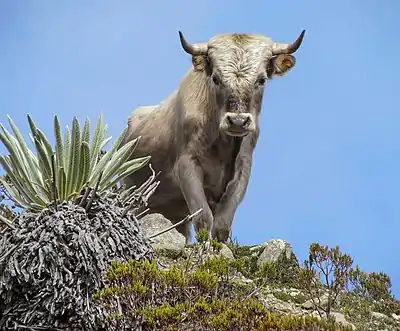The Venezuela Portal.svg.png.webp) Flag of Venezuela Venezuela (/ˌvɛnəˈzweɪlə/ VEN-ə-ZWAY-lə; Latin American Spanish: [beneˈswela] ⓘ), officially the Bolivarian Republic of Venezuela (Spanish: República Bolivariana de Venezuela), is a country on the northern coast of South America, consisting of a continental landmass and many islands and islets in the Caribbean Sea. Venezuela comprises an area of 916,445 km2 (353,841 sq mi), and its population was estimated at 29 million in 2022. The capital and largest urban agglomeration is the city of Caracas. The continental territory is bordered on the north by the Caribbean Sea and the Atlantic Ocean, on the west by Colombia, Brazil on the south, Trinidad and Tobago to the north-east and on the east by Guyana. Venezuela is a presidential republic consisting of 23 states, the Capital District and federal dependencies covering Venezuela's offshore islands. Venezuela is among the most urbanized countries in Latin America; the vast majority of Venezuelans live in the cities of the north and in the capital. Venezuela is a developing country having the world's largest known oil reserves and has been one of the world's leading exporters of oil. Previously, the country was an underdeveloped exporter of agricultural commodities such as coffee and cocoa, but oil quickly came to dominate exports and government revenues. The excesses and poor policies of the incumbent government led to the collapse of Venezuela's entire economy. The country struggles with record hyperinflation, shortages of basic goods, unemployment, poverty, disease, high child mortality, malnutrition, severe crime and corruption. These factors have precipitated the Venezuelan refugee crisis where more than seven million people have fled the country. By 2017, Venezuela was declared to be in default regarding debt payments by credit rating agencies. The crisis in Venezuela has contributed to a rapidly deteriorating human rights situation. Venezuela is a charter member of the United Nations (UN), Organization of American States (OAS), Union of South American Nations (UNASUR), Bolivarian Alliance for the Peoples of Our America (ALBA), Mercosur, Latin American Integration Association (LAIA) and Organization of Ibero-American States (OEI). (Full article...) Selected article -Santa Rosa de la Eminencia castle is a colonial castle built in the seventeenth century by the Spanish monarchy on Margarita Island, Venezuela. After a group of French pirates attacked the city of La Asunción, its construction started on 24 March 1677, by order of governor Juan Muñoz de Gadea, and it was finished c. 1683. The structure comprises three defensive fronts, each one with two bastions, two half bastions and three curtains, and is positioned at the top of a hill that overlooks the city The castle served as a prison for war heroine Luisa Cáceres de Arismendi between November 1815 and January 1816. She was held captive by the Spanish forces on an attempt to bow down her husband, Juan Bautista Arismendi, who was the chief of the patriotic forces on the island. Simón Bolívar's arrival to the island prompted the partial destruction and abandonment of the fort in May 1816. By 1899, the facility serviced as headquarters, and later as quarters for the National Army. It was declared as a National Monument in 1965. (Full article...)Selected pictureSelected biography - In this month... Laguna Victoria in the Sierra Nevada of Venezuela
Did you know (auto-generated) -
Selected list -The University City of Caracas is a World Heritage Site in Caracas, Venezuela. It is a functional university campus for the Central University of Venezuela, as well as home to 108 notable works of art and famous examples of creative architecture. Many works of art are modernist and mosaic. The campus was designed by architect Carlos Raúl Villanueva, who oversaw much of the construction and design work, with the artwork overseen by Mateo Manaure. Villanueva primarily enlisted artists who were either European or had European influences – Villanueva himself had been inspired for the campus design in Paris – including members of Los Disidentes, a group of Venezuelan artists who left for Europe to break from the Mexican mural tradition. Some artists did not initially want to work on the project, as they were opposed to the military dictatorship in place in Venezuela at the time, but French artist Fernand Léger encouraged them to participate by saying that "dictatorships pass but art remains"; part of Villanueva's intention was unity. Latin American art scholar Monica Amor wrote that Villanueva's Synthesis of the Arts philosophy, inspired by an André Bloc approach, "advocated a strong humanist approach to urban issues of reconstruction and social healing after the devastation of World War II." Amor noted that debate surrounding the dictatorship's funding of the project, and its realization in this context, persists into the 21st century. (Full article...)Current events
More did you know... Venezuelan patrol boat Naiguatá
TopicsCategoriesCategory puzzle Select [►] to view subcategories
Venezuela Venezuela-related lists Buildings and structures in Venezuela Venezuelan culture Economy of Venezuela Education in Venezuela Geography of Venezuela Government of Venezuela Health in Venezuela History of Venezuela Organizations based in Venezuela Venezuelan people Politics of Venezuela Society of Venezuela Images of Venezuela Venezuela stubs Recognized content
Featured articlesGood articles
Featured pictures
New articlesThis list was generated from these rules. Questions and feedback are always welcome! The search is being run daily with the most recent ~14 days of results. Note: Some articles may not be relevant to this project.
Rules | Match log | Results page (for watching) | Last updated: 2024-01-14 23:51 (UTC) Note: The list display can now be customized by each user. See List display personalization for details.
Things you can doWikiProjectsWikiProjects puzzle
Related portalsAssociated WikimediaThe following Wikimedia Foundation sister projects provide more on this subject:
Discover Wikipedia using portals
|

.jpg.webp)
_Chromatopelma_cyaneopubescens_-_Venezuela_-_Female.jpg.webp)








-1_peso_(1811%252C_First_Issue).jpg.webp)
-Venezuela_-_Caracas_-_Parque_del_Este_(72)-4.jpg.webp)